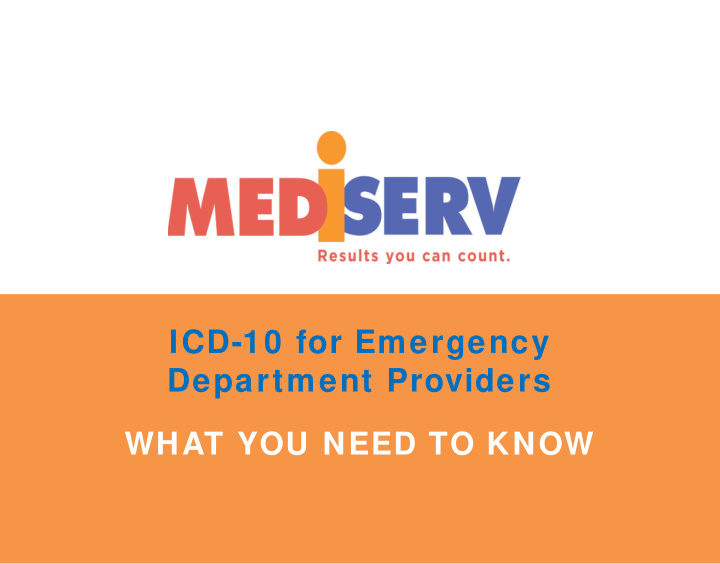



ICD-10 for Emergency Department Providers WHAT YOU NEED TO KNOW
Introduction • Begins October 1, 2015 • No clinical practice change; driven by goal to collect more accurate data • Really not an increased burden in documentation • Documenting facts that we are already gathering • Appendix for additional resources
Episode of Care Must reference episode of patient’s care • Initial Encounter (generally most ED visits) ex. Patient receives laceration repair • Subsequent Encounter ex. Patient returns for med adjustment • Sequela ex. Patient presents to the ER complaining of pain from the site of the healed laceration **Takeway: 99% of an ED provider’s visits will be “Initial Encounters” 3
Stage/Severity • For certain conditions, document the stage or severity, if known. • Examples: Diabetes: Type 1 or 2 o Decubitis/Pressure Ulcer Staging 1-5 o Chronic Kidney Disease Staging 1-5, ESRD o Asthma: o Intermittent or Persistent; AND o Mild, Moderate or Severe o Respiratory Failure: Acute or Chronic o Burns: 1 st , 2 nd , 3 rd o 4
Laterality • Detail of right, left or bilateral must be documented • Not just for injuries—both medical and traumatic conditions • Examples: o Acute, Suppurative, Otitis Media, right ear o Laceration, left ankle o Left upper quadrant (LUQ) abdominal pain • Other common conditions that require notation of laterality: o Joint pain/effusion o Injury o Fractures o Dislocations o Arthritis o Pressure ulcers o Cerebral infarction 5
Specific Anatomy ICD-10-CM supports much more precise anatomic description of the injury or condition • Arm or Leg – upper/lower or proximal/distal • Hand - document individual metacarpals • Foot - document individual metatarsals • Phalanges - document whether proximal, mid or distal phalanges • Face - document whether upper or lower eyelids and lips • Abscess/Cellulitis - document the precise anatomic location 6
External Causes of Injury • Document how the “how-what-why” of the cause of the injury • Ridiculous examples, but do not stress • Poisoning Document the type of drug (ex., aspirin) o Indicate how it occurred (accidental or unintentional) o • Under-dosing (New ICD-10 concept) Document the type of drug o Intentional or Unintentional o • Falls Document how the injury occurred o Indicate any sequential events that result in an injury (subsequent striking o against sharp glass) 7
UTI/Sepsis • ICD-10 eliminates the concept of urosepsis • Tips for documenting UTI: o Document Type: cystitis, pregnancy related, STD o Note infection agency if known: e.coli, candidiasis o Document location: cystitis, urethritis • If the patient is septic from a urinary condition, then document “sepsis” first, and identify UTI as the cause 8
Location of ICD-10 in Record • Include diagnosis details in MDM section or diagnosis section • Do not rely on references scattered throughout record or ancillary documents (lab reports, nurses notes, radiology reports, etc.) 9
Laterality Stage/ Episode of Care Severity External Cause Anatomical of Illness or Specificity Injury 10
APPENDIX Recommended Resources for Emergency Physicians • ICD-10 CM for the Busy Emergency Physician https://www.acep.org/uploadedFiles/ACEP/practiceResources/issuesByCategory/reimbursement/ICD-10- CM%20For%20The%20Busy%20Emergency%20Physician%206_2014.pdf • ICD-10 ED Clinical Examples https://www.acep.org/uploadedFiles/ACEP/practiceResources/issuesByCategory/reimbursement/ICD-10- CM%20ED%20Clinical%20Examples%206_2014.pdf • ICD-10 FAQs http://www.acep.org/Physician-Resources/Practice-Resources/Administration/Financial-Issues-/- Reimbursement/ICD-10-FAQ/ 11
Recommend
More recommend